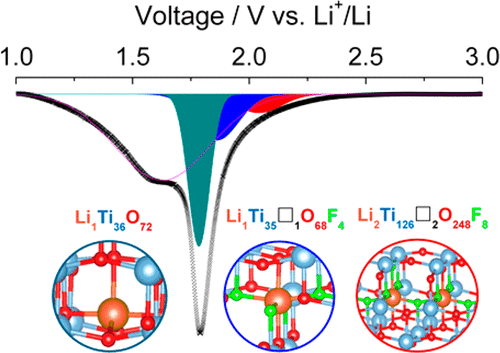当前位置:
X-MOL 学术
›
Chem. Mater.
›
论文详情
Our official English website, www.x-mol.net, welcomes your
feedback! (Note: you will need to create a separate account there.)
Lithium Intercalation in Anatase Titanium Vacancies and the Role of Local Anionic Environment
Chemistry of Materials ( IF 7.2 ) Pub Date : 2018-04-07 00:00:00 , DOI: 10.1021/acs.chemmater.8b00925 Jiwei Ma 1, 2 , Wei Li 1 , Benjamin J. Morgan 3 , Jolanta Światowska 4 , Rita Baddour-Hadjean 5 , Monique Body 6 , Christophe Legein 6 , Olaf J. Borkiewicz 7 , Sandrine Leclerc 1 , Henri Groult 1 , Frédéric Lantelme 1 , Christel Laberty-Robert 8, 9 , Damien Dambournet 1, 9
Chemistry of Materials ( IF 7.2 ) Pub Date : 2018-04-07 00:00:00 , DOI: 10.1021/acs.chemmater.8b00925 Jiwei Ma 1, 2 , Wei Li 1 , Benjamin J. Morgan 3 , Jolanta Światowska 4 , Rita Baddour-Hadjean 5 , Monique Body 6 , Christophe Legein 6 , Olaf J. Borkiewicz 7 , Sandrine Leclerc 1 , Henri Groult 1 , Frédéric Lantelme 1 , Christel Laberty-Robert 8, 9 , Damien Dambournet 1, 9
Affiliation

|
The structure of bulk and nondefective compounds is generally described with crystal models built from well mastered techniques such the analysis of an X-ray diffractogram. The presence of defects, such as cationic vacancies, locally disrupt the long-range order, with the appearance of local structures with order extending only a few nanometers. To probe and describe the electrochemical properties of cation-deficient anatase, we investigated a series of materials having different concentrations of vacancies, i.e., Ti1–x–y□x+yO2–4(x+y)F4x(OH)4y, and compared their properties with respect to defect-free stoichiometric anatase TiO2. At first, we characterized the series of materials Ti1–x–y□x+yO2–4(x+y)F4x(OH)4y by means of pair distribution function (PDF), 19F nuclear magnetic resonance (NMR), Raman and X-ray photoelectron spectroscopies, to probe the compositional and structural features. Second, we characterized the insertion electrochemical properties vs metallic lithium where we emphasized the beneficial role of the vacancies on the cyclability of the electrode under high C-rate, with performances scaling with the concentration of vacancies. The improved properties were explained by the change of the lithium insertion mechanism due to the presence of the vacancies, which act as host sites and suppress the phase transition typically observed in pure TiO2, and further favor diffusive transport of lithium within the structure. NMR spectroscopy performed on lithiated samples provides evidence for the insertion of lithium in vacancies. By combining electrochemistry and DFT-calculations, we characterized the electrochemical signatures of the lithium insertion in the vacancies. Importantly, we found that the insertion voltage largely depends on the local anionic environment of the vacancy with a fluoride and hydroxide-rich environments, yielding high and low insertion voltages, respectively. This work further supports the beneficial use of defects engineering in electrodes for batteries and provides new fundamental knowledge in the insertion chemistry of cationic vacancies as host sites.
中文翻译:

锐钛型钛空位中的锂嵌入和局部阴离子环境的作用
总体和无缺陷化合物的结构通常用从熟练的技术(例如X射线衍射图分析)建立的晶体模型来描述。缺陷的存在,例如阳离子空位,会局部破坏长程有序,而局部结构的出现只会延伸几纳米。为了探测和描述阳离子缺陷型锐钛矿的电化学性质,我们研究了一系列具有不同空位浓度的材料,即Ti 1– x – y □ x + y O 2–4(x + y) F 4 x( OH)4 ÿ,并比较了它们在无缺陷化学计量锐钛矿型TiO 2方面的性能。起初,我们表征了一系列材料的Ti 1- X - ý □ X + Ý Ö 2-4(X + Ý) ˚F 4 X(OH)4 ý通过对分布函数的装置(PDF),19F核磁共振(NMR),拉曼光谱和X射线光电子能谱,以探测其组成和结构特征。其次,我们表征了插入电化学性质与金属锂的相对性质,其中我们强调了空位对电极在高C速率下的可循环性的有益作用,其性能随空位浓度而定。由于空位的存在,锂插入机制的变化解释了性能的改善,这些空位充当了宿主位点并抑制了通常在纯TiO 2中观察到的相变,并且进一步有利于锂在结构内的扩散传输。对锂化样品进行的NMR光谱分析为空位中插入了锂提供了证据。通过结合电化学和DFT计算,我们表征了空位中锂插入的电化学特征。重要的是,我们发现插入电压很大程度上取决于空位的局部阴离子环境,以及富含氟化物和氢氧化物的环境,分别产生高插入电压和低插入电压。这项工作进一步支持缺陷工程在电池电极中的有益应用,并提供了阳离子空位作为宿主位点的插入化学的新基础知识。
更新日期:2018-04-07
中文翻译:

锐钛型钛空位中的锂嵌入和局部阴离子环境的作用
总体和无缺陷化合物的结构通常用从熟练的技术(例如X射线衍射图分析)建立的晶体模型来描述。缺陷的存在,例如阳离子空位,会局部破坏长程有序,而局部结构的出现只会延伸几纳米。为了探测和描述阳离子缺陷型锐钛矿的电化学性质,我们研究了一系列具有不同空位浓度的材料,即Ti 1– x – y □ x + y O 2–4(x + y) F 4 x( OH)4 ÿ,并比较了它们在无缺陷化学计量锐钛矿型TiO 2方面的性能。起初,我们表征了一系列材料的Ti 1- X - ý □ X + Ý Ö 2-4(X + Ý) ˚F 4 X(OH)4 ý通过对分布函数的装置(PDF),19F核磁共振(NMR),拉曼光谱和X射线光电子能谱,以探测其组成和结构特征。其次,我们表征了插入电化学性质与金属锂的相对性质,其中我们强调了空位对电极在高C速率下的可循环性的有益作用,其性能随空位浓度而定。由于空位的存在,锂插入机制的变化解释了性能的改善,这些空位充当了宿主位点并抑制了通常在纯TiO 2中观察到的相变,并且进一步有利于锂在结构内的扩散传输。对锂化样品进行的NMR光谱分析为空位中插入了锂提供了证据。通过结合电化学和DFT计算,我们表征了空位中锂插入的电化学特征。重要的是,我们发现插入电压很大程度上取决于空位的局部阴离子环境,以及富含氟化物和氢氧化物的环境,分别产生高插入电压和低插入电压。这项工作进一步支持缺陷工程在电池电极中的有益应用,并提供了阳离子空位作为宿主位点的插入化学的新基础知识。











































 京公网安备 11010802027423号
京公网安备 11010802027423号